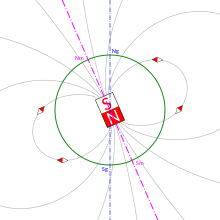The Earth, like all other magnets also has its own magnetic field that extends from the inner core to outer space. Earth's core as we have studied it to be, is made up of molten iron and other metals which are in liquid state which is a very good conductor. The Earth's magnetic field is like no other permanent magnet because its polarity keeps changing.
At random intervals the Earth's field reverses (the north and south geomagnetic poles change places with each other). These reversals leave a record in rocks that allow paleomagnetists to calculate past motions of continents and ocean floors as a result of plate tectonics. Good for us that these reversals take about a million years to slowly reverse.
 Origin: The Earth's magnetic field is mostly caused by electric currents in the liquid outer core, which is composed of highly conductive molten iron.The motion of the fluid is sustained by convection, motion driven by buoyancy. The temperature increases towards the center of the Earth, and the higher temperature of the fluid lower down makes it buoyant. This buoyancy is enhanced by chemical separation: As the core cools, some of the molten iron solidifies and is plated to the inner core. In the process, lighter elements are left behind in the fluid, making it lighter. This is called compositional convection. A Coriolis effect, caused by the overall planetary rotation, tends to organize the flow into rolls aligned along the north-south polar axis.
Origin: The Earth's magnetic field is mostly caused by electric currents in the liquid outer core, which is composed of highly conductive molten iron.The motion of the fluid is sustained by convection, motion driven by buoyancy. The temperature increases towards the center of the Earth, and the higher temperature of the fluid lower down makes it buoyant. This buoyancy is enhanced by chemical separation: As the core cools, some of the molten iron solidifies and is plated to the inner core. In the process, lighter elements are left behind in the fluid, making it lighter. This is called compositional convection. A Coriolis effect, caused by the overall planetary rotation, tends to organize the flow into rolls aligned along the north-south polar axis.
 Origin: The Earth's magnetic field is mostly caused by electric currents in the liquid outer core, which is composed of highly conductive molten iron.The motion of the fluid is sustained by convection, motion driven by buoyancy. The temperature increases towards the center of the Earth, and the higher temperature of the fluid lower down makes it buoyant. This buoyancy is enhanced by chemical separation: As the core cools, some of the molten iron solidifies and is plated to the inner core. In the process, lighter elements are left behind in the fluid, making it lighter. This is called compositional convection. A Coriolis effect, caused by the overall planetary rotation, tends to organize the flow into rolls aligned along the north-south polar axis.
Origin: The Earth's magnetic field is mostly caused by electric currents in the liquid outer core, which is composed of highly conductive molten iron.The motion of the fluid is sustained by convection, motion driven by buoyancy. The temperature increases towards the center of the Earth, and the higher temperature of the fluid lower down makes it buoyant. This buoyancy is enhanced by chemical separation: As the core cools, some of the molten iron solidifies and is plated to the inner core. In the process, lighter elements are left behind in the fluid, making it lighter. This is called compositional convection. A Coriolis effect, caused by the overall planetary rotation, tends to organize the flow into rolls aligned along the north-south polar axis.
Approximations:
Near the surface of the Earth, its magnetic field can be closely approximated by the field of a magnetic dipole positioned at the center of the Earth and tilted at an angle of about 11° with respect to the rotational axis of the Earth. The dipole is roughly equivalent to a powerful bar-magnet, with its south pole pointing towards the geomagnetic North Pole. This may seem surprising, but the north pole of a magnet is so defined because it is attracted towards the Earth's north pole. Since the north pole of a magnet attracts the south poles of other magnets and repels the north poles, it must be attracted to the south pole of Earth's magnet. The dipolar field accounts for 80–90% of the field in most locations.
Measurement of Intensity: The intensity of the field is greatest near the poles and weaker near the Equator. It is generally reported in nanoteslas (nT) or gauss, with 1 gauss = 100,000 nT. It ranges from about25,000–65,000 nT, or 0.25–0.65 gauss. By comparison, a strong refrigerator magnet has a field of about 100 gauss.
The average magnetic field in the Earth's outer core was calculated to be 25 Gauss, 50 times stronger than the field at the surface.
Importance:
Humans have used compasses for direction finding since the 11th century A.D. and for navigation since the 12th century.
The Earth is largely protected from the solar wind, a stream of energetic charged particles emanating from the Sun, by its magnetic field, which deflects most of the charged particles. These particles would strip away the ozone layer, which protects the Earth from harmful ultraviolet rays.Calculations of the loss of carbon dioxide from the atmosphere of Mars, resulting from scavenging of ions by the solar wind, are consistent with a near-total loss of its atmosphere since the magnetic field of Mars turned off.
This field that protects us is called the magnetosphere.










0 comments:
Post a Comment